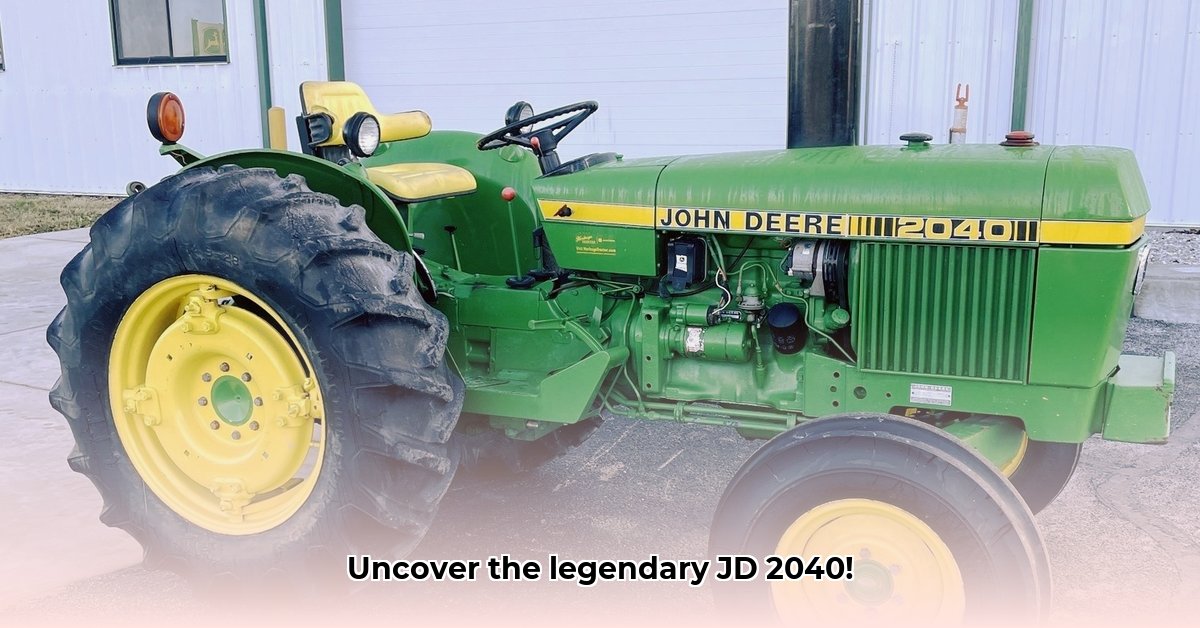
The John Deere 2040, manufactured between 1976 and 1982, represents a significant chapter in the history of agricultural machinery. This guide provides a comprehensive technical overview and historical perspective on this dependable utility tractor, appealing to both vintage tractor enthusiasts and those interested in the evolution of agricultural technology. We'll delve into its specifications, design innovations, market context, and collector's considerations. For more on similar vintage tractors, check out this Ford 2910 resource.
Technical Specifications: A Detailed Look
The JD 2040 wasn't the largest or most powerful tractor, but its design prioritized reliability and efficiency for smaller to medium-sized farm operations. Key specifications are outlined below:
| Specification | Value | Notes |
|---|---|---|
| Engine | 2.7L, 3-cylinder diesel | Reliable and fuel-efficient, characteristic of tractors from this era. |
| Power (claimed PTO) | 40 hp | Manufacturer's rated power output at the power take-off (PTO). |
| Power (tested PTO) | 40.86 hp | Independent testing showed slightly higher actual PTO horsepower. |
| Transmission | 8-speed collar shift | A straightforward, robust transmission, common in tractors of its time. |
| Fuel Tank Capacity | 16.5 gallons | Required more frequent refueling compared to larger tractors. |
| Hydraulic System | Initially open-center, later closed-center (from serial # 266750) | A significant upgrade improving efficiency and smoothness of operation. |
| Lift Capacity (24") | 2400 lbs | Sufficient for various tasks on smaller to medium-sized farms. |
| Drive Type | Two-wheel drive | Rear-wheel drive was standard for utility tractors in this period. |
| Other Features | Power steering, rear differential lock | Enhanced maneuverability and traction, especially in challenging conditions. |
Design and Innovation: Evolutionary Advancements
The JD 2040's design reflected the typical engineering practices of the late 1970s. While not revolutionary, several aspects are noteworthy. The later models' adoption of a closed-center hydraulic system significantly improved performance and operational smoothness. This upgrade demonstrates John Deere's ongoing refinement of its designs. However, the use of a 9-inch dry-disc clutch, while reliable, was already established technology. The moderate lift capacity further suggests its intended role as a versatile utility tractor for smaller farms. Did this moderate approach contribute to its enduring popularity?
Market Context and Performance: Finding its Niche
Precise sales figures for the JD 2040 are scarce, making a precise competitive comparison difficult. However, its specifications and John Deere's reputation suggest it targeted the utility tractor segment. Its 2.7L three-cylinder engine likely offered a balance between output and fuel efficiency, though potentially placing it below competitors with larger engines. How did this balance impact farmer choice in the late 1970s?
Historical Significance: A Chapter in Agricultural History
The JD 2040 represents a significant step in the continuous evolution of agricultural technology. While it wasn't a radical departure from existing designs, its reliability and suitability for a range of tasks made it a popular choice. Its later closed-center hydraulic systems represent an important incremental improvement reflective of industry trends. What role did this tractor play in shaping farming practices during this period?
Collector's Perspective: Restoring a Piece of History
The JD 2040 offers a rewarding restoration project for vintage tractor enthusiasts. The serial number is crucial for verifying authenticity and ordering correct parts. Online forums and specialized parts dealers are invaluable resources. Common repair needs might include hydraulic seals or clutch components. Precise part identification is often challenging, making the serial number even more significant. How has access to online resources and community forums affected the restoration process for these tractors?
Conclusion: A Lasting Legacy
The JD 2040 was a dependable and versatile utility tractor that played a prominent role in the agricultural landscape of its time. While not a revolutionary machine, its simple design and reliable performance contributed to its lasting legacy. Its place in agricultural history and its appeal to collectors highlight its enduring significance within the broader context of farming technology.